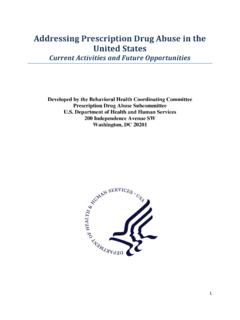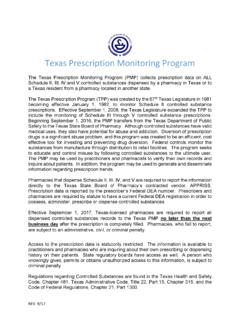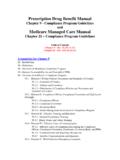Transcription of WHAT IS A PDMP? 249M - cdc.gov
1 prescription drug . monitoring PROGRAMS (PDMPs). Checking the PDMP: An Important Step to Improving Opioid Prescribing Practices WHAT IS A PDMP? 249M. A PDMP is a statewide electronic database prescriptions for opioids that tracks all controlled substance were written by healthcare prescriptions. Authorized users can access providers in 2013. prescription data such as medications dispensed and doses. PDMPs improve patient safety by allowing clinicians to: Identify patients who are obtaining opioids from multiple providers. Calculate the total amount of opioids prescribed per day (in MME/day). Identify patients who are being prescribed other substances that may increase risk of opioids such as benzodiazepines. enough prescriptions for every American adult to have a bottle of pills Improving the way opioids WHEN SHOULD I CHECK THE PDMP? are prescribed will ensure State requirements patients have access vary, but CDC. to safer, more effective recommends chronic pain treatment checking at least once every while reducing opioid misuse, abuse, and 3 months and overdose.
2 Checking your state's PDMP is consider checking an important step in safer prescribing of prior to every opioid prescription . these drugs. L E A R N M O R E | WHAT SHOULD I CONSIDER WHEN PRESCRIBING OPIOIDS? High Multiple drug Dosage Providers Interactions Counsel your patient and coordinate Whenever possible, avoid Talk to your patient about the care with their other prescribers to prescribing opioids and risks for respiratory depression improve safety and discuss the need to benzodiazepines concurrently. and overdose. Consider offering to obtain opioids from a single provider. Communicate with other taper opioids as well as prescribing Check the PDMP regularly and prescribers to prioritize patient naloxone for patients taking 50. consider tapering or discontinuation of goals and weigh risks of concurrent MME/day or more. opioids if pattern continues. opioid and benzodiazepine use. WHAT SHOULD I DO IF I FIND INFORMATION ABOUT A PATIENT IN THE PDMP. THAT CONCERNS ME?
3 Patients should not be dismissed from care based on PDMP information. Use the opportunity to provide potentially life-saving information and interventions. 1 Confirm that the information in the PDMP is correct. Check for potential data entry errors, use of a nickname or maiden name, or possible identity theft to obtain prescriptions. 2 Assess for possible misuse or abuse. Offer or arrange evidence-based treatment (usually medication-assisted treatment with buprenorphine or methadone in combination with behavioral therapies) for patients who meet criteria for opioid use disorder. If you suspect diversion, urine drug testing can assist in determining whether opioids can be discontinued without causing withdrawal. 3 Discuss any areas of concern with your patient and emphasize your interest in their safety. HOW CAN I REGISTER AND USE. THE PDMP IN MY STATE? Processes for registering and using PDMPs vary from state to state. For information on your state's requirements, check The National Alliance for Model State drug Laws online: L E A R N M O R E |














